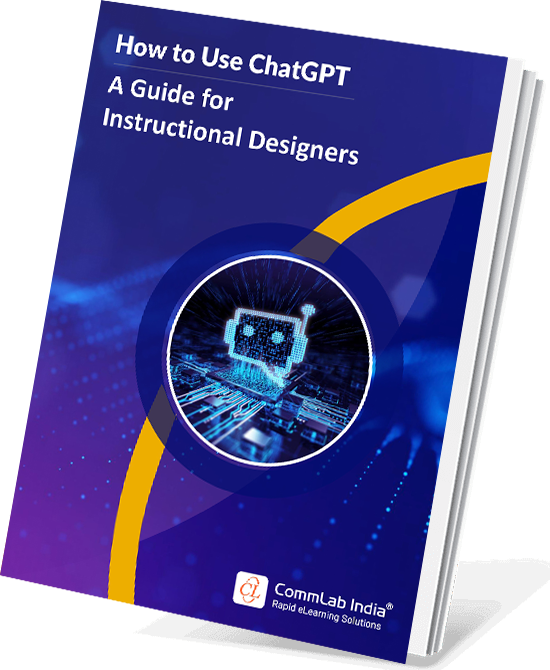Ever wondered how some eLearning courses manage to keep learners hooked from start to finish? That’s not magic—it’s the power of instructional design at work! By blending psychology, creativity, and technology, instructional design transforms learning content into engaging, interactive experiences that captivate learners and drive results.
What is Instructional Design?
Instructional design (ID) or Instructional System Design (ISD) is a systematic approach to designing and developing training materials that deliver meaningful and immersive learning experiences. It is the art and science of crafting training courses aligned with business goals that help enhance employee knowledge and skills, improve their performance, and boost productivity.
Why is Instructional Design Important in Learning & Development?
In classroom training, the trainer guides learners through the curriculum, involves them in the learning process, and also clarifies their doubts, leading to meaningful learning. Things are different when it comes to online or digital learning. Ensuring learner engagement in a virtual learning environment is a major pain point for L&D and training managers. Designing and developing learner-centric eLearning courses is the only way to offer immersive learning experiences that boost employee performance and productivity.
Instructional design is at the core of designing unforgettable learning experiences as it aligns learning objectives with business goals to achieve desired learning outcomes. Without sound instructional design, eLearning courses would be mere content to read through.
Watch this video to explore how instructional design contributes to corporate L&D.
Chapters
What are the Origins of Instructional Design?
The concept of instructional design came into existence in the 1940s during World War II, when learning specialists were asked to create training materials for thousands of soldiers to help them master sophisticated weapons. Things have evolved over the decades — instructional design has transitioned its focus from mere skills and knowledge acquisition to crafting personalized learning journeys to make learning an immersive experience.
Read this blog for deeper insights into the history and evolution of instructional design.
The Evolution of Instructional Design
What are the Key Milestones and Who are the Influential Theorists in Instructional Design?
Here’s an infographic that showcases instructional design key milestones.
Image Courtesy: Instructional Design Central
How Has Technology Impacted the Evolution of Instructional Design?
The advent of new technology in the field of instructional design is noteworthy. With the infusion of sophisticated and modern electronic gadgets such as smartphones, tablets, and iPads, mobile learning has been becoming popular. The increasing popularity of social media among the youth is also being tapped by instructional designers and they are encouraging social and collaborative learning through online communities and discussion forums.
In present times, AI is playing a pivotal role in learning design. Instructional designers are using AI algorithms to craft personalized learning journeys for learners. Gamification is another popular instructional design approach to make learning enjoyable, especially for Gen Z learners. Modern technologies such as Augmented Reality (AR) and Virtual Reality (VR) offer new avenues for instructional designers to craft immersive learning experiences.

How to Use ChatGPT — A Guide for Instructional Designers
Create Immersive Learning Experiences by leveraging ChatGPT
- Frame Learning Objectives
- Generate Scenarios
- Design Assessments
- And More!
What are the Key Principles and Theories in Instructional Design?
What are the Main Learning Theories in Instructional Design?
Here are three essential learning theories of instructional design:
Behaviorism
Behaviorism focuses on observable behaviors and how they’re influenced by stimuli from the environment. It emphasizes the role of reinforcement and punishment in shaping learner behavior. B.F. Skinner and John Watson are the key figures associated with the theory of behaviorism. In instructional design, the principles of behaviorism are applied through techniques such as repetition, drills, and positive reinforcement to encourage desired learning outcomes.
Cognitivism
Cognitivism centers on the inner mental activities of the learner. It views learning as a process of acquiring and organizing knowledge, emphasizing the importance of mental processes such as thinking, memory, knowing, and problem-solving. Prominent theorists who supported the theory of cognitivism include John Sweller, Jean Piaget, and Jerome Bruner. Instructional design based on cognitivism involves strategies that enhance understanding and retention, such as using metaphors, analogies, and structured content.
Constructivism
Constructivism posits that learners construct their understanding and knowledge of the world through experiences and reflecting on those experiences. It emphasizes active learning, where learners build on their prior knowledge and engage in problem-solving and critical thinking. Key proponents of the theory of constructivism include Lev Vygotsky and Jean Piaget. In instructional design, constructivist approaches involve collaborative learning, real-world problem-solving, and activities that encourage exploration and discovery.
How do Andragogy and Pedagogy Differ?

Adult learners are different from children. While children are always curious to learn something new, adults look for ‘What’s in it for me?’. Adults have life experiences that influence their learning while children are free from prejudices and pre-conceived notions.
As an instructional designer, having a fair understanding of the learning styles, preferences, and expectations of adult learners is the first stepping stone to designing an impactful learning program.
Read this blog to understand Malcolm Knowles’ five principles of adult learning and how they can be used to design successful online learning.
5 Adult Learning Principles: The Secret Behind Successful Online Training
What are the Important Instructional Design Models?
An instructional design (ID) model is a framework that helps instructional designers to structure the process of course design. This framework offers a set of clear guidelines that assist instructional designers in designing effective courses based on sound instructional design principles.
Here’s an infographic that lists four popular instructional design models for designing learner-centric eLearning courses.
What is the Instructional Design Process?
How is a Needs Analysis Conducted in Instructional Design?
Needs analysis is crucial to identify the existing performance gaps and to determine if training can fulfill those deficits.
Here are the six steps to conduct training need analysis:
- Set the desired outcomes
- Prioritize competencies
- Evaluate desired competencies
- Find the performance gaps
- Select the training methods
- Consider the costs and benefits
Read this blog to delve into the details.
Six Simple Steps to Conduct Training Needs Analysis
How are Learning Objectives Defined in the Instructional Design Process?
Learning objectives or LOs are the roadmap to designing learner-centric eLearning courses. They help instructional designers align learning with business goals.
Here’s an infographic that walks you through the importance of learning objectives in developing eLearning courses.
Crafting clear learning objectives is crucial to designing meaningful learning experiences.
Read this blog to explore how to frame SMART (specific, measurable, achievable, relevant, time-bound) learning objectives.
How to Craft Clear Learning Objectives for Winning Custom eLearning Courses?
What are the Steps Involved in Content Development for Instructional Design?
Content development for instructional design involves several key steps to ensure that the material is effective and engaging for learners. These steps help ensure that the instructional content is well-designed, engaging, and effective in meeting the learning needs of the audience.
Here’s an overview of the process:
- Needs Analysis: Identify the learning needs, goals, and objectives. Understand the target audience and the context in which the learning will take place.
- Research and Information Gathering: Collect relevant information, resources, and materials that will form the basis of the content. This includes academic research, industry standards, and subject matter expertise.
- Design and Planning: Outline the structure and flow of the content. Develop a storyboard or blueprint that maps out the learning modules, activities, assessments, and multimedia elements.
- Content Creation: Develop the actual content, including text, graphics, videos, and interactive elements. Ensure that the content aligns with the learning objectives and is accessible to all learners.
- Review and Feedback: Conduct reviews and gather feedback from stakeholders, including subject matter experts, instructional designers, and potential learners. Make necessary revisions based on the feedback.
- Implementation: Deploy the content in the chosen learning platform or environment. This could be an online learning management system (LMS), a classroom setting, or a blended learning approach.
- Evaluation and Assessment: Monitor and evaluate the effectiveness of the content. Use assessments, surveys, and analytics to measure learner engagement and achievement of learning objectives.
- Revision and Improvement: Based on the evaluation results, make continuous improvements to the content. Update and refine the material to keep it relevant and effective.

How to Use ChatGPT — A Guide for Instructional Designers
Create Immersive Learning Experiences by leveraging ChatGPT
- Frame Learning Objectives
- Generate Scenarios
- Design Assessments
- And More!
How are Assessments Designed to Measure Learning Outcomes?
Assessments are integral to assessing learning outcomes. In eLearning courses, we have two types of assessments — formative assessment (conducted after each learning point) and summative assessment (conducted at the end of the course).
This infographic walks you through the steps to design flawless eLearning assessments.
Conventional knowledge-based assessments frequently fail to accurately gauge the practical use of skills and knowledge. Performance-based eLearning assessments address this gap by providing a more engaging and effective method for evaluating learners. These assessments emphasize the application of knowledge and skills in real-world contexts, rather than just recalling information.
Read this blog to explore the benefits of performance-based eLearning assessments and get effective design tips.
Performance-Based eLearning Assessments — Key Benefits & Design Tips for Success
What are the Tools and Technologies Used in Instructional Design?
What are Learning Management Systems (LMS) and How are They Used in Instructional Design?
A Learning Management System (LMS) is a software application designed to facilitate the creation, delivery, and management of training programs. You can host all your online training courses on this platform for easy access for your learners and to streamline the training and development process in your organization.
Uses of LMS in Instructional Design
Course Creation: Instructional designers use LMS platforms to develop and organize course materials, including multimedia content, quizzes, and assignments. This ensures a structured and engaging learning experience.
Content Delivery: LMS platforms enable the delivery of content in various formats (videos, PDFs, interactive modules) and support synchronous and asynchronous learning.
Assessment and Feedback: LMS tools allow for the creation of assessments and provide immediate feedback to learners. This helps in evaluating learner performance and understanding.
Tracking and Reporting: LMS platforms offer analytics and reporting features that help instructional designers monitor learner progress, identify areas for improvement, and adjust instructional strategies accordingly.
Collaboration and Communication: LMS platforms often include forums, chat, and messaging features that facilitate communication and collaboration among learners and instructors. Instructional designers can make a note of the discussion points and implement them for better learning.
Watch this video to explore the amazing features of new-age LMS.
What are Some Popular Authoring Tools Used in Instructional Design?
Authoring tools are essential for instructional designers as they simplify and enhance the process of creating engaging and effective learning materials. They relieve you from the pain of complex programming and help design courses in just a few clicks.
Here are a few benefits of authoring tools for instructional designers:
- Authoring tools offer pre-designed themes and templates allowing IDs to quickly create visually appealing content.
- These tools also offer a rich repository of multimedia elements such as videos, audio, images, and animations to make the learning experience more dynamic and engaging.
- Authoring tools include features for creating interactive assessments. You can create quick quizzes and gamified assessments to evaluate learners.
- Cloud-based authoring tools allow multiple IDs to collaborate in real time, making it easier to work on projects together irrespective of geographical location and time zone.
- Instructional designers can save and reuse content created using authoring tools across different courses. This ensures consistency and saves time.
Choose the authoring tool that’s just right for you. Access Authoring Tool Finder [Free Tool].
Here’s a list of popular authoring tools:
- Articulate 360
- Adobe Captivate
- iSpring Suite
- Lectora
- Elucidat
- Easygenerator
- dominKnow
- Camtasia
- Gomo
- Adapt
Read the blog to learn more about them.
Looking for the Ideal eLearning Authoring Tool? Explore the List of the Top 10!
How are Multimedia Elements Utilized in Instructional Design?
Multimedia elements breathe life into training courses. Here are the top 6 multimedia elements to augment the effectiveness of your eLearning courses:
- Videos
- Graphics and images
- Audio
- Animations
- Gamified Components
- Interactive Quizzes
Watch this video to learn how to create multimedia-rich content for eLearning courses.
What are the Emerging Technologies Influencing Instructional Design?
In present times, innovation and digitization are at the heart of corporate training. L&D managers across the globe are embracing new tools and technologies to craft immersive learning experiences that enhance learner performance and productivity.
Here are a few new learning technologies ruling the L&D space:
- Generative Artificial Intelligence (AI)
- Augmented Reality and Virtual Reality (AR/VR)
- Mobile Learning
- Learning Experience Platforms (LXPs)
Here’s an eBook that helps you learn the art of creating effective prompts to harness the power of AI to design immersive learning experiences.
What are the Best Practices in Instructional Design?
How Can Content Be Aligned with Learning Objectives in Instructional Design?
Learning objectives are critical to the success of eLearning programs. Aligning the content with the learning objectives is crucial to designing eLearning courses that engage learners, aid them succeed in the assessments, and help achieve learning outcomes.
Here’s a blog that provides insights into aligning learning content, strategies, and assessments with learning objectives for effective eLearning.
Learning Objectives: The Key to E-learning Content, Instructional Strategy, & Assessments
What Techniques are Effective for Engaging Learners in Instructional Design?
Learner engagement is challenging when it comes to online learning. Here are a few tips to design learner-centric eLearning courses to boost learner engagement:
- Mix and match different learning formats
- Leverage intrinsic and extrinsic motivation
- Facilitate response from the learners
- Incorporate collaborative learning
- Solicit learner feedback
Read this blog to delve deep.
5 Tips to Design eLearning Courses that Boost Learner Engagement in Corporate Training
How Can Accessibility and Inclusivity be Ensured in Instructional Design?
Ensuring accessibility and inclusivity in instructional design is crucial for creating an equitable learning environment. Here are some key strategies:
- Follow the Universal Design for Learning (UDL) Method: This method involves creating content, assessments, and teaching strategies that offer various ways for learners to understand, express, and engage with the material. By providing diverse options and flexibility, UDL ensures that learners can interact with the content in ways that best meet their unique needs and preferences.
- Use Inclusive Language and Visual Elements: Using language that avoids gender bias and stereotypes creates an inclusive environment. Additionally, using diverse and representative images that reflect various cultures, abilities, and backgrounds helps learners feel included and valued.
- Abide by the Accessibility Guidelines: Following guidelines like the Web Content Accessibility Guidelines (WCAG) and Section 508 guarantees that eLearning content is accessible to people with disabilities. This includes offering alternatives for visual and auditory content, using proper color contrast, ensuring screen-reader compatibility, and designing navigation that can be used with a keyboard.
- Target a Diverse Group for User Testing and Gather Feedback: Engaging a diverse group of learners in user testing helps collect feedback on accessibility, usability, and the overall learning experience. Incorporating this feedback into ongoing improvement efforts enhances inclusivity and addresses any accessibility challenges.
- Use a Variety of Training Methods: Implementing varied training methods, such as classroom training, group discussions, eLearning, virtual instructor-led training (VILT), simulations, and microlearning modules can cater to different learning styles and needs.
Watch this video to explore how Articulate Storyline can help you create accessible eLearning.
What Methods Can Be Used for Continuous Improvement Through Feedback in Instructional Design?
Continuous improvement in instructional design relies heavily on gathering and utilizing feedback effectively.
Here are some methods to achieve this:
- Having an Iterative Refinement Process: Implementing an iterative design process allows for continuous refinement of instructional materials. This involves regularly reviewing and updating content based on feedback and performance data.
- Establishing a Culture of Consistent Feedback: Creating an environment where feedback is valued and encouraged is essential. This involves regular communication with learners, trainers, Subject Matter Experts (SMEs), and other stakeholders to gather their insights and suggestions.
- Collaborating with Key Stakeholders: Engaging with subject matter experts, trainers, and learners in the design process ensures that diverse perspectives are considered. This collaboration can lead to more comprehensive and effective instructional materials.
- Embracing New Technology and Leveraging Analytics: Leveraging technology, tools, and analytics can streamline the feedback collection process and provide deeper insights into learner behavior and performance.
- Making Data-Driven Decisions: Collecting and analyzing data from assessments, surveys, and performance metrics helps identify areas for improvement. This data-driven approach ensures that decisions are based on concrete evidence rather than assumptions.
By integrating these methods, instructional designers can create a dynamic and responsive learning environment that continuously evolves to meet the needs of all learners.

How to Use ChatGPT — A Guide for Instructional Designers
Create Immersive Learning Experiences by leveraging ChatGPT
- Frame Learning Objectives
- Generate Scenarios
- Design Assessments
- And More!
What are the Common Challenges Faced in Instructional Design and Strategies to Overcome Them?
Instructional design can be a complex process with several common challenges. Here are some of the key ones with strategies to overcome them:
#Challenge 1: Budget Constraints
Limited financial resources can restrict the tools, technologies, and resources available for creating high-quality instructional materials. This can impact the overall effectiveness and engagement of the learning experience.
How to overcome it?
Focus on essential elements that directly impact learning outcomes. Allocate resources to high-priority areas first. Utilize free or low-cost tools to supplement instructional materials.
#Challenge 2: Time Constraints
Tight deadlines can pressure instructional designers to deliver content quickly, often at the expense of thoroughness and quality. Balancing the need for timely delivery with the need for comprehensive, well-designed materials is a constant challenge.
How to overcome it?
Invest time in efficient planning. Develop a detailed project plan with clear timelines and milestones. Distribute tasks among team members based on their strengths and expertise to ensure efficient use of time. Have an agile project management process in place to break tasks into manageable chunks and deliver iterative improvements.
Related Read: Rapid Instructional Design: Comprehensive Guide for Beginners
#Challenge 3: Resistance to Change
Implementing new instructional methods or technologies can meet resistance from trainers, learners, or stakeholders who are accustomed to traditional approaches.
How to overcome it?
Overcoming this resistance requires effective communication, training, and demonstrating the benefits of the new methods. Offer training and ongoing support to help trainers and learners adapt to new tools and approaches. Engage stakeholders in the decision-making process to address their concerns, so they feel invested in the process.
#Challenge 4: Engagement and Relevance
Ensuring that the content is engaging and relevant to all learners can be difficult.
How to overcome it?
Instructional designers must find ways to make the material interesting and applicable to diverse audiences. Incorporate multimedia, interactive elements, and real-world examples to make content engaging. Use adaptive learning technology to tailor content to meet the diverse needs and interests of learners.
#Challenge 5: Information Overload
Presenting too much information at once can overwhelm learners.
How to overcome it?
Instructional designers need to strike a balance between providing comprehensive content and avoiding cognitive overload. Break down content into digestible microlearning nuggets. Use clear headings, subheadings, and visual aids to organize content logically. Focus on presenting ‘need-to-know’ content in the course and provide highlights and summaries to reinforce content.
What are the Future Trends in Instructional Design?
Robust instructional design is the foundation of a learner-centric eLearning course. Let’s talk about the trends shaping the future of eLearning and creating more engaging, learner-centric experiences:
Storytelling:
Everyone loves a good story! It’s not just for books and movies—storytelling in eLearning captivates learners and makes concepts stick like never before.
Collaborative and Social Learning:
Learning is better together! Encouraging teamwork and interaction builds a sense of community and helps learners grow through shared experiences.
Microlearning:
Bite-sized brilliance! Short, focused lessons make content easier to digest and perfect for on-the-go learners.
Blended Learning:
The best of both worlds! Combine the flexibility of online learning with the personal touch of face-to-face sessions for a truly immersive learning experience.
Gamification:
Level up learning! Game-like elements such as rewards, challenges, and leaderboards make courses fun, engaging, and highly motivating.
Personalized Learning:
One size doesn’t fit all. Tailored courses address various learner needs, preferences, and pace, making the learning journey much more effective.
Immersive Learning:
Step into another world! Technologies like AR, VR, and simulations create real-world scenarios, letting learners practice and explore in a risk-free environment.
Curious to learn more? Dive into our blog for deeper insights into these trends and how they can transform your eLearning design!
7 Instructional Design Trends That Will Shape the Future of Workplace Learning
Parting Thoughts
Instructional design is the cornerstone of crafting engaging learning materials that lead to meaningful learning and boost employee performance and productivity to achieve business goals. Hope this step-by-step guide helps you on your journey to design and develop courses that take your corporate L&D initiatives to greater heights. To match the pace of rapidly evolving L&D needs, we bring you a power-packed guide to leverage the power of Generative AI to pave the path to crafting immersive learning experiences. Here’s an eBook “How to Use ChatGPT — A Guide for Instructional Designers”. Grab your copy now to usher in a revolutionary approach to instructional design with ChatGPT.














